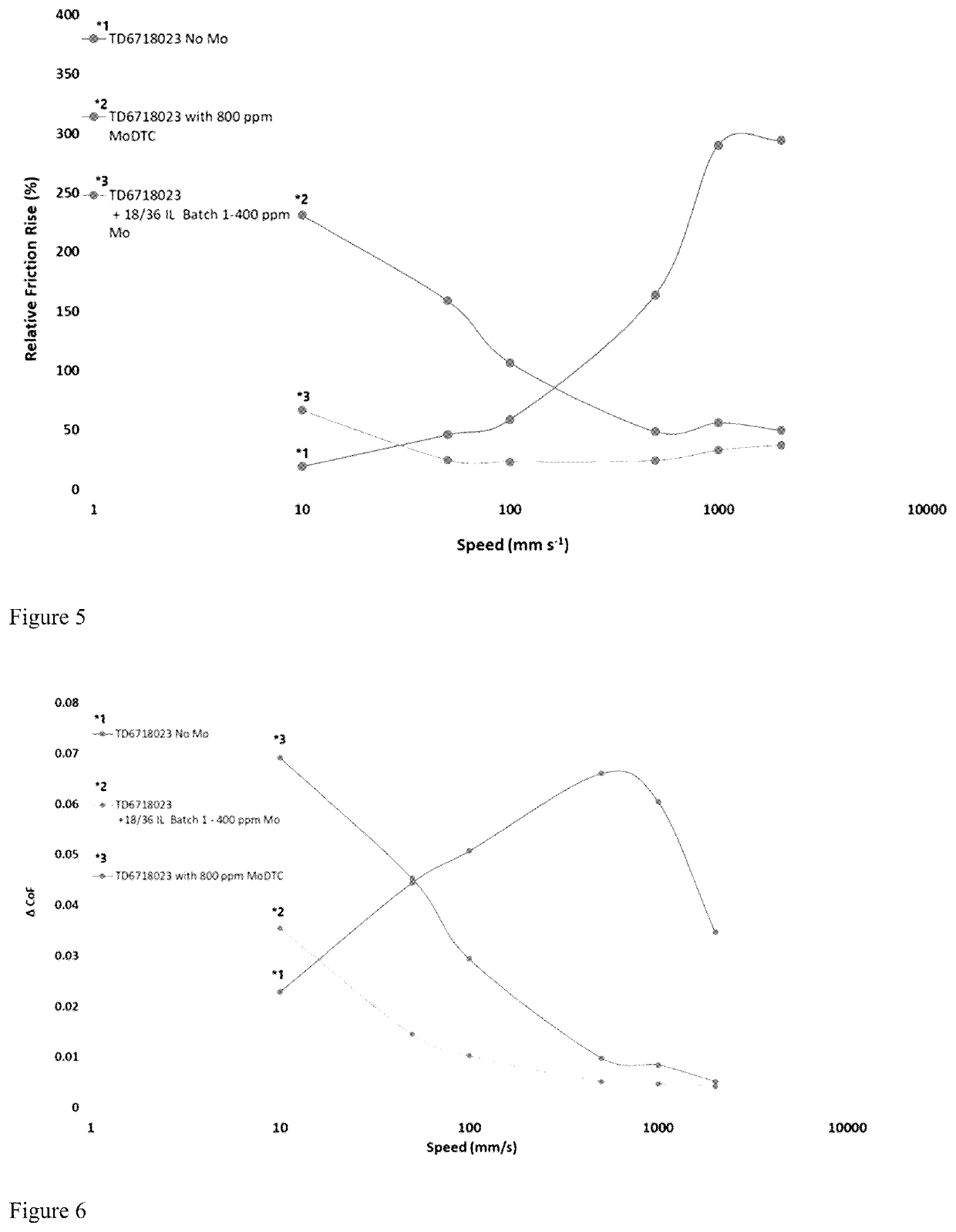Friction and wear reduction additives
a friction and additive technology, applied in the direction of additives, lubricant compositions, organic chemistry, etc., can solve the problems of limited cations of the salts the ineffective use of hydrocarbylammonium thiomolybdates to those disclosed in the documents, and the inability to improve the extreme pressure properties of the greases. , to achieve the effect of thickening the greases with substituted urea, the effect of differen
- Summary
- Abstract
- Description
- Claims
- Application Information
AI Technical Summary
Benefits of technology
Problems solved by technology
Method used
Image
Examples
example 1
[0213]The ionic liquid bis(trihexyltetradecylphosphonium) tetrathiomolybdate was synthesised by following the procedure of a metathesis reaction between trihexyltetradecylphosphonium chloride and ammonium tetrathiomolybdate in an organic solvent, followed by removal of the solvent and high vacuum drying.
example 2
[0214]The ionic liquid bis(trioctylmethylphosphonium) tetrathiomolybdate was synthesised by a metathesis reaction between trioctylmethylphosphonium methylcarbonate and ammonium tetrathiomolybdate in an organic solvent such as methanol, followed by removal of the solvent and high vacuum drying. The ionic liquid bis(trihexyltetradecylphosphonium) tetrathiomolybdate was added to a fully formulated base oil in an amount of 1 wt. % by total weight of the lubricating oil composition. The base oil was 0w-16 oil.
[0215]The anti-wear properties of the lubricating oil composition comprising the ionic liquid were compared to the anti-wear properties of a lubricating oil composition comprising no anti-wear or anti-friction additive, and a lubricating oil composition comprising a comparable amount of the commercially available antifriction and anti-wear additive MoDTC. The anti-wear properties were measured by High Frequency Reciprocating Rig (HFRR) and are shown in the table below. The HFRR test...
example 3
[0219]The following three ionic liquids of the present invention were synthesised and tested.
[0220]IL 18 / 03—Bis(trihexyltetradecylphosphonium) tetrathiomolybdate ionic liquid—prepared by halide route with ˜3% chloride.
[0221]IL 18 / 36—Bis(trioctylmethylphosphonium) tetrathiomolybdate ionic liquid—prepared by non-halide route.
[0222]IL 18 / 39—Bis(trihexyltetradecylphosphonium) molybdate ionic liquid—prepared by halide route with ˜3% chloride.
[0223]The above ionic liquids were tested and compared to the commercially available additive molybdenum dithiocarbamate (MoDTC) in a high frequency reciprocating rig test (HFRR).
[0224]The HFRR test is a standard test known in the art for assessing the lubricating properties of fuel, adapted for use in testing lubricating oil compositions. The test conditions were Load=400 g, T=120° C., Stoke=2000μ, Frequency=20 Hz, Duration=1 h.
[0225]The results of the test are shown below in Tables 2 and 3.
TABLE 2Treat rateMean(wt %FrictionWearinclusion ofMoCoeffic...
PUM
| Property | Measurement | Unit |
|---|---|---|
| temperature | aaaaa | aaaaa |
| temperature | aaaaa | aaaaa |
| temperature | aaaaa | aaaaa |
Abstract
Description
Claims
Application Information
 Login to View More
Login to View More - R&D
- Intellectual Property
- Life Sciences
- Materials
- Tech Scout
- Unparalleled Data Quality
- Higher Quality Content
- 60% Fewer Hallucinations
Browse by: Latest US Patents, China's latest patents, Technical Efficacy Thesaurus, Application Domain, Technology Topic, Popular Technical Reports.
© 2025 PatSnap. All rights reserved.Legal|Privacy policy|Modern Slavery Act Transparency Statement|Sitemap|About US| Contact US: help@patsnap.com



